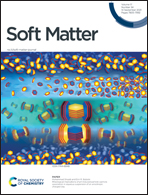Deformation of membrane vesicles due to chiral surface proteins
Abstract
Chiral, rod-like molecules can self-assemble into cylindrical membrane tubules and helical ribbons. They have been successfully modeled using the theory of chiral nematics. Models have also predicted the role of chiral lipids in forming nanometer-sized membrane buds in the cell. However, in most theoretical studies, the membrane shapes are considered fixed (cylinder, sphere, saddle, etc.), and their optimum radii of curvatures are found variationally by minimizing the energy of the composite system consisting of membrane and chiral nematics. Numerical simulations have only recently started to consider membrane deformation and chiral orientation simultaneously. Here we examine how deformable, closed membrane vesicles and chiral nematic rods mutually influence each other's shape and orientation, respectively, using Monte Carlo (MC) simulation on a closed triangulated surface. For this, we adopt a discrete form of chiral interaction between rods, originally proposed by Van der Meer et al., for off-lattice simulations. In our simulation, both conical and short cylindrical tubules emerge, depending on the membrane stiffness and the intrinsic chirality of the molecules. We show that the Helfrich–Prost term, which couples nematic tilt with local membrane curvature in continuum models, can account for most of the observations in the simulation. At higher chirality, our theory also predicts a chiral tweed phase on cones, with varying bandwidths.



 Please wait while we load your content...
Please wait while we load your content...